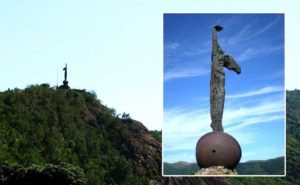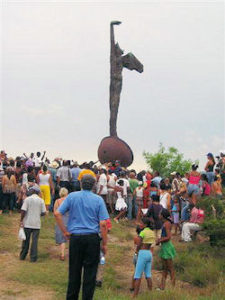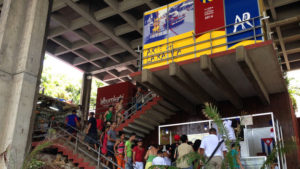![]() Cimarrón in Cuba is synonymous with warrior. The term began to be used here and elsewhere in America at the time when European metropolises colonizing the so-called ‘New continent’.
Cimarrón in Cuba is synonymous with warrior. The term began to be used here and elsewhere in America at the time when European metropolises colonizing the so-called ‘New continent’.
For then there was a railway domination marked by the slavery of million of people, although many slaves, fuerza de will, changed his destination. Those who managed to escape the severe repression began to call them Maroons.
Slavery, which, in the words of José Martí, “it is the great shame of the world,” reigned for many years in the largest of the Antilles, leaving numerous traces in this society that carries a mixture of multiple traditions and African Customs.
Story has it that back in the year 1729, the inhabitants of the village of copper in Santiago de Cuba were forced by the Governor of the town, Pedro Ignacio Jiménez, to perform strenuous work of mining, and restoration to serve the Spanish Crown. Even is says that some were going to be sold as if were slaves.
The inhabitants of that village were former African slaves who were engaged in mining, but when activity ceased to be profitable to their owners, some were there to work in agriculture and livestock.
One day men who underwent revolted and ―como the Maroons – escaped towards the closest palenques to free themselves from exploitation.
Finally the Crown had that give and in 1801 is les granted its Charter of emancipation, much time before is abolished definitely it slavery in Cuba in 1886.
Two centuries later, the recognized sculptor Cuban, Alberto Lescay, built just in that site, a stunning monument as worthy recognition to which staged that Act of rebellion.
It monument to the Cimarron, located in them remains of an old Hill called the verdigris, in the village of the copper, near the basilica of the Church of the charity of the copper near Santiago of Cuba. measures almost 10 meters of height and is stands as if were contemplating the steps of those men that a time were stripped of their lands and of their rights.
From a distance, can see this modeled work in bronze and other recycled materials, which we can only see close after climbing more than 300 steps. A time facing it, is currency the silhouette of a figure perhaps mythical because through elements figurative represents the freedom from multiple interpretations.
He monument to the Cimarron form part of a project of it organization them Nations United for it education, the science and the culture (UNESCO), called the route of the slave whose purpose is aimed to disclose the reality of that form of exploitation and its influence in them cultures American.
The work of Lescay on copper is a way of not forgetting history and honor the resistance and rebellion of men who rise against oppression.
Agencies/encyclopedia/Ruth Soto Falcon/Internet Photos/Excerpts/Arnoldo Varona/TheCubanHistory.com
THE CUBAN HISTORY, HOLLYWOOD.
MONUMENTO AL CIMARRÓN, EL COBRE, CUBA: LA RUTA DEL ESCLAVO.
Decir cimarrón en Cuba es sinónimo de guerrero. El término comenzó a usarse aquí y en otras regiones de América en la época en que las Metrópolis europeas colonizaban el llamado “Nuevo continente”.
Para entonces existía una férrea dominación marcada por la esclavitud de millones de personas, aunque muchos esclavos, a fuerza de voluntad, cambiaron su destino. A quienes lograron escapar de la severa represión comenzó a llamárseles cimarrones.
La esclavitud, que en palabras de José Martí “es la gran pena del mundo”, reinó por muchos años en la Mayor de Las Antillas, dejando numerosas huellas en esta sociedad que lleva la mezcla de múltiples tradiciones y costumbres africanas.
Cuenta la historia que allá por el año 1729, los habitantes del poblado del Cobre en Santiago de Cuba fueron obligados por el gobernador de la villa, Pedro Ignacio Jiménez, a realizar extenuantes labores de minería, y restauración para servir a la corona española. Incluso se comenta que algunos iban a ser vendidos como si fuesen esclavos.
Los habitantes de aquel poblado eran antiguos esclavos africanos que se dedicaban a la minería, pero cuando la actividad dejó de ser rentable para sus dueños, algunos se quedaron allí para trabajar en la agricultura y la ganadería.
Cierto día los hombres que fueron sometidos se sublevaron y ―como los cimarrones— escaparon hacia los palenques más cercanos para liberarse de la explotación.
Finalmente la corona tuvo que ceder y en 1801 se les otorgó su carta de emancipación, mucho tiempo antes de que se aboliera definitivamente la esclavitud en Cuba en 1886.
Dos siglos después, el reconocido escultor cubano, Alberto Lescay, edificó justamente en aquel sitio, un impresionante monumento como digno reconocimiento a los que protagonizaron aquel acto de rebeldía.
El Monumento al Cimarrón, ubicado en los restos de un antiguo cerro llamado el Cardenillo, en el pueblo del Cobre, cerca de la basilica de la Iglesia de la Caridad del Cobre cerca de Santiago de Cuba. mide casi 10 metros de altura y se yergue como si estuviera contemplando los pasos de aquellos hombres que una vez fueron despojados de sus tierras y de sus derechos.
Desde lejos puede divisarse esta obra modelada en bronce y otros materiales reciclados, la cual solo podemos ver de cerca después de escalar más de 300 escalones. Una vez frente a ella, se divisa la silueta de una figura quizás mítica porque a través de elementos figurativos representa la libertad desde múltiples interpretaciones.
El Monumento al Cimarrón forma parte de un proyecto de la Organización las Naciones Unidas para la Educación, la Ciencia y la Cultura (UNESCO), llamado la Ruta del Esclavo cuyo propósito está encaminado a divulgar la realidad de esa forma de explotación y su influencia en las culturas americanas.
La obra de Lescay en el Cobre es una manera de no olvidar la historia y de honrar la resistencia y la rebeldía de los hombres que se levantan en contra de la opresión.
Agencies/Enciclopedia/Ruth Soto Falcón/Internet Photos/Extractos/Arnoldo Varona/TheCubanHistory.com
THE CUBAN HISTORY, HOLLYWOOD.













